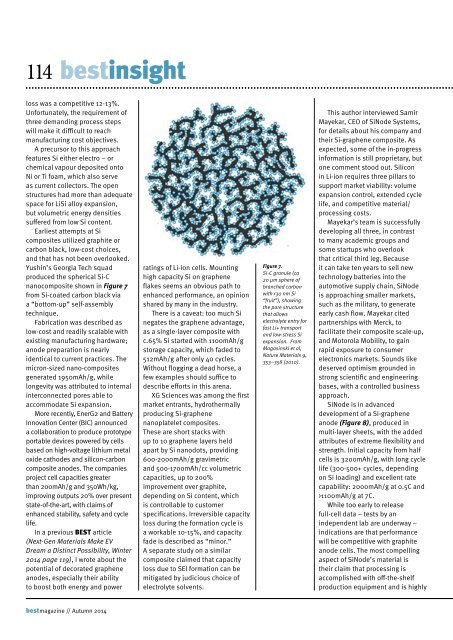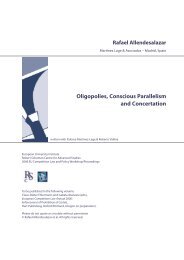You also want an ePaper? Increase the reach of your titles
YUMPU automatically turns print PDFs into web optimized ePapers that Google loves.
114 bestinsightloss was a competitive 12‐13%.Unfortunately, the requirement ofthree demanding process stepswill make it difficult to reachmanufacturing cost objectives.A precursor to this approachfeatures Si either electro – orchemical vapour deposited ontoNi or Ti foam, which also serveas current collectors. The openstructures had more than adequatespace for LiSi alloy expansion,but volumetric energy densitiessuffered from low Si content.Earliest attempts at Sicomposites utilized graphite orcarbon black, low‐cost choices,and that has not been overlooked.Yushin’s Georgia Tech squadproduced the spherical Si‐Cnanocomposite shown in Figure 7from Si‐coated carbon black viaa “bottom‐up” self‐assemblytechnique.Fabrication was described aslow‐cost and readily scalable withexisting manufacturing hardware;anode preparation is nearlyidentical to current practices. Themicron‐sized nano‐compositesgenerated 1950mAh/g, whilelongevity was attributed to internalinterconnected pores able toaccommodate Si expansion.More recently, EnerG2 and BatteryInnovation Center (BIC) announceda collaboration to produce prototypeportable devices powered by cellsbased on high‐voltage lithium metaloxide cathodes and silicon‐carboncomposite anodes. The companiesproject cell capacities greaterthan 200mAh/g and 350Wh/kg,improving outputs 20% over presentstate‐of‐the‐art, with claims ofenhanced stability, safety and cyclelife.In a previous BEST article(Next‐Gen Materials Make EVDream a Distinct Possibility, Winter2014 page 119), I wrote about thepotential of decorated grapheneanodes, especially their abilityto boost both energy and powerratings of Li‐ion cells. Mountinghigh capacity Si on grapheneflakes seems an obvious path toenhanced performance, an opinionshared by many in the industry.There is a caveat: too much Sinegates the graphene advantage,as a single‐layer composite withc.65% Si started with 1100mAh/gstorage capacity, which faded to512mAh/g after only 40 cycles.Without flogging a dead horse, afew examples should suffice todescribe efforts in this arena.XG Sciences was among the firstmarket entrants, hydrothermallyproducing Si‐graphenenanoplatelet composites.These are short stacks withup to 10 graphene layers heldapart by Si nanodots, providing600‐2000mAh/g gravimetricand 500‐1700mAh/cc volumetriccapacities, up to 200%improvement over graphite,depending on Si content, whichis controllable to customerspecifications. Irreversible capacityloss during the formation cycle isa workable 10‐15%, and capacityfade is described as “minor.”A separate study on a similarcomposite claimed that capacityloss due to SEI formation can bemitigated by judicious choice ofelectrolyte solvents.Figure 7.Si-C granule (ca20 μm sphere ofbranched carbonwith 1100mAh/g at 7C.While too early to releasefull‐cell data – tests by anindependent lab are underway –indications are that performancewill be competitive with graphiteanode cells. The most compellingaspect of SiNode’s material istheir claim that processing isaccomplished with off‐the‐shelfproduction equipment and is highlybestmagazine // Autumn 2014



